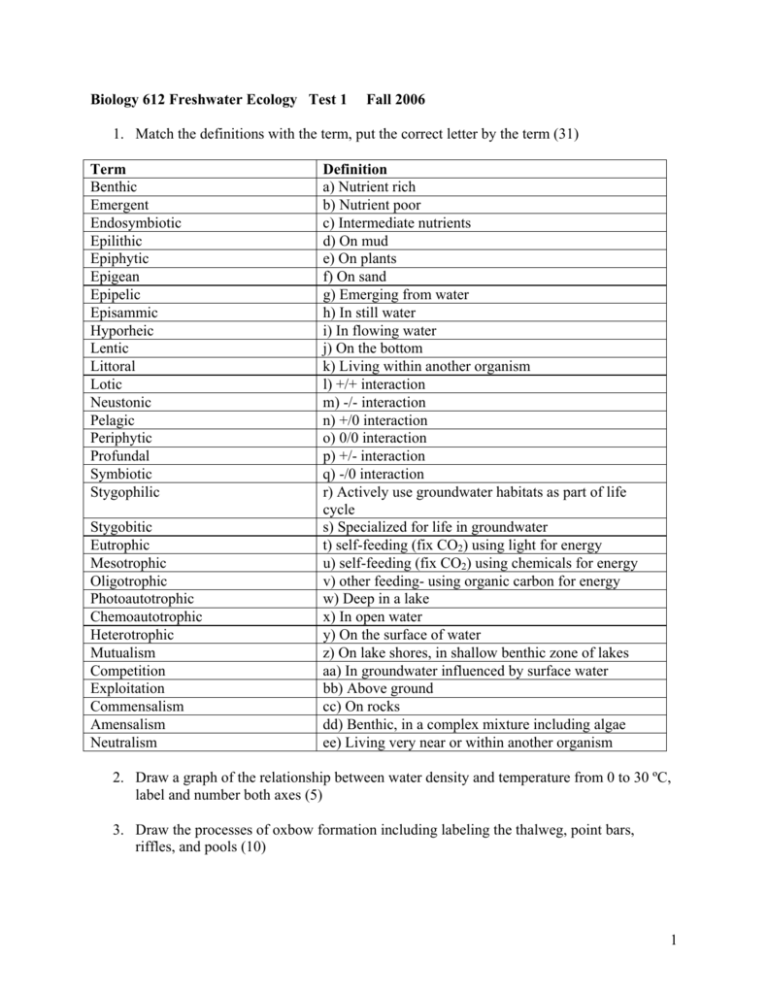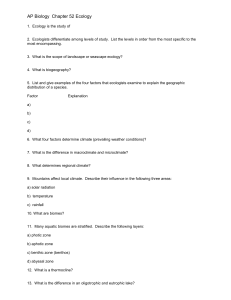1 Biology 612 Freshwater Ecology Test 1 Fall 2006 1. Match the
advertisement

Biology 612 Freshwater Ecology Test 1 Fall 2006 1. Match the definitions with the term, put the correct letter by the term (31) Term Benthic Emergent Endosymbiotic Epilithic Epiphytic Epigean Epipelic Episammic Hyporheic Lentic Littoral Lotic Neustonic Pelagic Periphytic Profundal Symbiotic Stygophilic Stygobitic Eutrophic Mesotrophic Oligotrophic Photoautotrophic Chemoautotrophic Heterotrophic Mutualism Competition Exploitation Commensalism Amensalism Neutralism Definition a) Nutrient rich b) Nutrient poor c) Intermediate nutrients d) On mud e) On plants f) On sand g) Emerging from water h) In still water i) In flowing water j) On the bottom k) Living within another organism l) +/+ interaction m) -/- interaction n) +/0 interaction o) 0/0 interaction p) +/- interaction q) -/0 interaction r) Actively use groundwater habitats as part of life cycle s) Specialized for life in groundwater t) self-feeding (fix CO2) using light for energy u) self-feeding (fix CO2) using chemicals for energy v) other feeding- using organic carbon for energy w) Deep in a lake x) In open water y) On the surface of water z) On lake shores, in shallow benthic zone of lakes aa) In groundwater influenced by surface water bb) Above ground cc) On rocks dd) Benthic, in a complex mixture including algae ee) Living very near or within another organism 2. Draw a graph of the relationship between water density and temperature from 0 to 30 ºC, label and number both axes (5) 3. Draw the processes of oxbow formation including labeling the thalweg, point bars, riffles, and pools (10) 1 4. Describe the process of formation of stratification in a dimictic lake (draw or use text) making sure to label or describe the epilimnion, metalimnion and hypolimnion (10) 5. There is a spill of 0.093 g/ cm3 density, very viscous oil though the vadose zone and into the water table of an aquifer used for drinking water. Part of the aquifer is heterogenous and the other is homogenous. David Letterman would ask, will the oil float or sink into the aquifer (3)? 6. The particles and spaces between them in the vadose zone and aquifer are very small. In the aquifer, will the water or the oil have a higher flow velocity and how is the flow rate related to Reynolds number (3)? 7. An engineer recommends the spill be cleaned up before it reaches the heterogeneous portion of the aquifer, why do you think this may be a concern (3)? 8. You sample an oligotrophic and a eutrophic lake. In which lake will light generally be transmitted deeper? What color of light do you expect to be transmitted most deeply in the oligotrophic lake? What color do you expect to be transmitted most deeply in the eutrophic lake (6)? 9. Why are fish streamlined, but many small swimming algae not (3)? 10. List 5 economic values of freshwater (10) 11. Why can we not use all the water that falls as precipitation on the surface of the earth (3)? 12. I talked about sinking of the filamentous diatom Melosira in lecture. Why does the longer filament not sink as rapidly as a sphere with the same volume, why is it good for this pelagic diatom that lives in the epilimnion to be filamentous (5)? 13. Why are many wetlands dependent upon groundwater? What do you expect is happening to many wetlands in western Kansas with depletion of the High Plains (Ogalla) aquifer? What game animals may be negatively impacted by this (8)? 2 Biology 612 Exam 2 Fall 2006 1. Draw the carbon cycle as it was presented in class (20) 2. Draw the nitrogen cycle as it was presented in class (20) 3. Describe the Lake Nyos disaster, including what processes led up to it, why it could not have happened in an alkaline (high pH) lake, and what effects it had (10) 4. Why can high sulfate water lead to increased phosphorus concentrations in water, and what is the role of iron and sulfate reduction in this situation (10) 5. Write the equations for photosynthesis and respiration (2) 6. Fill in the blank, 1 point each (18) Cyanobacteria produce ___________ to inhibit predators. The technical name for mayflies is ________________. Plecoptera have the common name of __________ and trichoptera _____________. One bioassessment index is based on these three groups of aquatic insects and is called the _______index. _______________ have glass cell walls. Microcrustacean zooplankton include the ______________, or water fleas such as Daphnia and closely related ______________ that have naupliar developmental stages. Within habitat diversity is referred to as __________ and between habitat as __________. Lake Biakal has a very high proportion of endemic _________ because it is very ___________. Many species of __________________ are threatened with extinction, in part because the host fish for their larvae are also threatened. The number of species is a type of diversity termed _______________ and the relative degree of similarity of proportions of different species in an area called _____________. As the area of a habitat increases, the number of species found in that area ____________. The rate of extinction is currently much ______________ than the rate of evolution of new species. ___________________ is one of the most difficult types of pollution to reverse, there are no known cases of the problem being reversed once it is well established. 7. Match the terms with their related terms (write the letter of the term in the second column next to the term it matches in the first column) (20) 3 Term Hormone mimic Biomagnification Bioconcentration LD50 ED50 Redox potential Dissolved compound Gravitoidal particle Conductivity pH Robert Wetzel Gene Likens Aluminum BOD Pmax Potential energy Fish kill Increasing amount of energy for uptake Michelle Evans-White Food web tracers Related term a) Ecoestrogen b) Dose that causes symptoms in half the organisms c) A particle that sinks d) Ability of aquatic solution to conduct electricity, related to salinity e) –log10 of concentration of hydrogen ions in solution f) More soluble in low pH g) Biological and chemical oxygen demand h) Process of increasing concentration up the food web i) Influential limnologist who studied periphyton photosynthesis j) Maximum rate of photosynthesis k) Dose that kills half the exposed organisms l) NH4+, NO3-, N2 m) Process of increasing concentration into organisms from the environment n) A measure of free electrons in solution o) A compound that passes through a fine filter p) Foremost contemporary scientist specializing in biogeochemistry of ecosystems q) High temperature/ low dissolved oxygen r) Study of genetically modified corn in streams s) Reduced compound in oxidized environment t) Natural abundance of stable isotopes 4 Biology 612 Freshwater Ecology Test 3 Fall 2006 1. Explain how protein structure must change (specifics please) in response to extremely hot and extremely cold environments (5). 2. Why are extremely oligotrophic environments extreme and what are two examples of extremely oligotrophic aquatic environments (6)? 3. What is the Redfield ratio, and how can it be used to indicate nutrient limitation of freshwater primary producers (5)? 4. What are the two nutrients that most often limit primary producers in freshwater habitats and what empirical methods are used to establish this (4)? 5. Why does uptake not immediately exhaust dissolved nutrient pools like nitrate or phosphate (2)? 6. Why is it important to try to stop cultural eutrophication before the hypolimnion goes anoxic (5)? 7. How do lake managers link improvements in the trophic state of lakes to changes in land use and point sources of loading, including calculating lake clarity and chlorophyll concentrations (6)? 8. What is the purpose of “activated sludge”, the sludge return to the secondary treatment, in modern sewage treatment plants (5)? 9. Explain the random walk strategy for positive chemotaxis (5). 10. Contrast the microbial food web to a traditional view of a lake foodweb (5). 11. What limits the lower range of particle sizes that Daphnia can consume and what limits the upper ranges (4)? 12. How does food quality and quantity relate to filtering rates of Daphnia (4)? 13. What did Deb Walks talk about (5)? 14. What did Justin Murdock talk about (5)? 15. What are some adaptations of Daphnia to predation (5)? 16. Why is complete removal of macrophytes from lakes oftentimes not a desirable management goal (4)? 5 17. Why is the Kansas River rarely anoxic now, but it often was in the lower reaches in the 1960’s (4)? 18. Describe the Paradox of the Plankton, and give 5 solutions to the paradox (10)? 19. Match the term in the left column with its corresponding letter in the right column (1 point each, 11 total) Item to be matched Match Everglades A concentration versus growth Monod equation B concentration versus uptake Michaelis-menten equation C organisms have different competitive abilities for different nutrients Grass carp D found above the water surface Virus E cane fields endanger native grass by nutrient runoff Resource ratio theory F midge mutualism Nostoc G common in stream foodwebs Omnivory H desiccation resistant life stages Temporary pools I all organisms have these Pluestonic J macrophyte control Interference competition K release a chemical that harms your competitor 6 Biology 612 final Fall 2006 1. Draw the carbon cycle as presented in class and label all fluxes (15) 2. Contrast the inertia, viscosity and Reynolds number of a large walleye and a bacterium and explain why it is more essential for the walleye to be streamlined than the bacterium, and why the fish needs gills but the bacterium doesn’t (10) 3. There are two lakes, one oligotrophic and the other eutrophic. On the following table, circle each attribute’s corresponding characteristic for the eutrophic lake, as opposed to the oligotrophic lake (10) Attribute Color Probability of anoxia Light extinction Secchi depth Primary production External nutrient loading Shoreline development index FePO4 in sediments Taste and odor problems Chlorophyll concentration Relative scaling in eutrophic compared to oligotrophic Green Blue Low High Low High Deep Shallow High Low High Low Low High Always stable Low High Dissolves with hypoxia High Low 4. Describe the river continuum concept, from a headwater stream in a forested region to a large river, with regard to the importance of primary production versus allocthonous inputs (leaves), functional feeding groups of macroinvertebrates, primary food sources for the feeding groups, and types of fish (15) 5. For the zooplankter Daphnia, describe the following (15) Why is it able to filter feed particles of only a certain size? What adaptations to predation does it have? What is its circulatory system like? What is its reproductive life cycle like (e.g. sex of offspring, type of eggs)? How does filtering rate vary as a function of food concentration? 6. List 5 extreme habitats and why they are extreme (10) 7. How has the view of lake ecosystems changed with respect to a simple model of trophic level based on large phytoplankton, zooplankton, zooplanktiverous fish, and pisciverous fish with regard to omnivory (microbes and other organisms, primary source or organic carbon (autotrophic versus heterotrophic) and the importance of benthic habitat (littoral versus pelagic) (10) 7 8. List 10 potentially unique economic values of freshwater habitats. These can be values from rivers and streams, lakes, or wetlands (10) 9. Give the equations for photosynthesis and respiration and label both (5) 8









